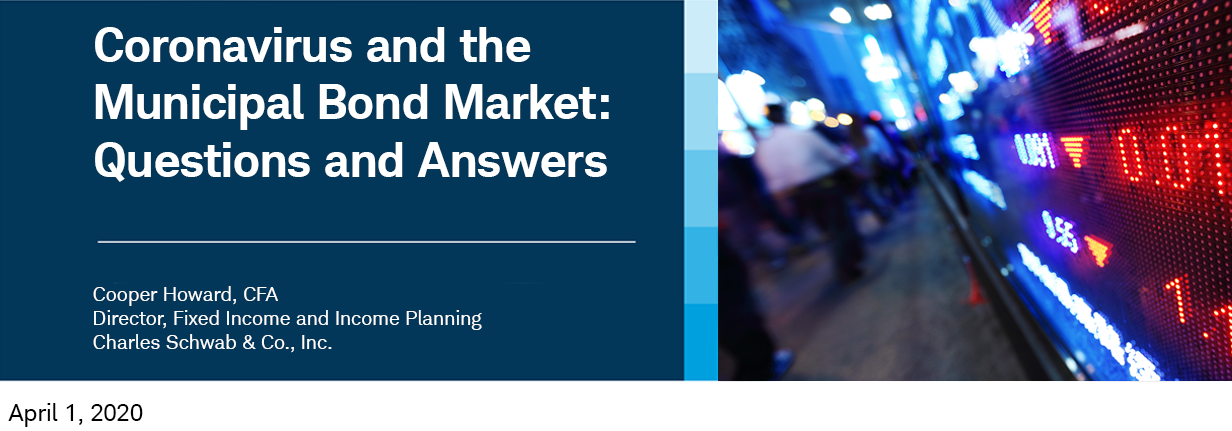
The municipal bond market has been hit especially hard by coronavirus containment efforts and recent market volatility. Many investors are asking what’s happening and what they should do now. Here are our answers to some of the most frequently asked questions:
I thought munis were supposed to be a defensive asset. Why have they been so volatile recently?
The recent volatility in the municipal bond market has been remarkable. Year-to-date (YTD) returns for the muni market were more than 3.7% on March 9th, but quickly reversed—by March 23rd, YTD returns were negative 7.6%. A move of that magnitude in that short a period of time has not occurred in the past 40 years.
The recent volatility in the municipal bond market has been extreme

Source: Bloomberg Barclays Municipal Bond Index, as of 03/26/2020.
Past performance is no guarantee of future results.
One factor that has worsened volatility is the lack of liquidity in the muni market—that is, the ability to get a reasonable price in a reasonable time frame when buying or selling a security. One of the reasons that liquidity dried up was because of significant outflows from muni mutual funds and exchange-traded funds (ETFs). As illustrated in the chart below, after experiencing more than 50 straight weeks of inflows, muni ETFs and mutual funds experienced four straight weeks of outflows.
Muni fund flows have turned substantially negative

Source: Investment Company Institute (ICI), as of 3/25/2020. Data is for estimated weekly fund flows.
Note: Weekly fund flows are estimates based on reporting covering more than 98% of mutual fund and ETF assets. Mutual fund data represent net new cash flow, which is new sales minus redemptions combined with net exchanges, while ETF data represent net issuance, which is gross issuance less gross redemptions. Data for mutual funds that invest primarily in other mutual funds and ETFs that invest primarily in other ETFs were excluded from the series.
In some cases, fund managers have been forced to sell bonds to meet clients’ redemption requests. This can create a vicious circle, as increased selling can lead to lower prices and even worse negative total returns, which then prompt more redemptions.
Will liquidity return to more-normal levels soon?
We believe it will, because of actions taken by the Federal Reserve and Congress. Among other recent actions, the Fed has implemented a program that essentially lets municipal money market funds get a loan from the Fed rather than sell securities to meet redemption requests. This should ease liquidity concerns for short-term munis.
Moreover, the economic stimulus bill that was signed into law on March 27th makes $454 billion available to the Federal Reserve to make loans, loan guarantees, and other aid to eligible businesses, states, and local governments. This includes purchasing municipal bonds regardless of maturity; previously, the Fed could purchase only munis that mature in six months or less. Theoretically, if a fund faces a significant amount of redemptions, the Fed could step in to purchase those bonds and be the source of liquidity.
With many states and local governments issuing “stay at home” or “shelter in place” orders, how will this affect the credit quality of muni issuers? Are there certain sectors that look more or less attractive right now?
We expect the “stay at home” orders will have a negative impact on the credit quality of many state and local governments, but to different degrees based on the sector and issuer. We expect there to be credit downgrades for many muni issuers, but do not expect widespread defaults.
State governments receive a large portion of their revenues from income taxes, sales taxes and governmental transfers. Income and sales taxes should decline due to the economic slowdown. Most states have benefited from the long and slow economic recovery since 2008, and have taken steps to shore up their balance sheets. For example, the median state rainy-day fund reached 7.6% of general fund expenditures in fiscal year 2019.1 In a report from 2019, Moody’s found that all states other than Illinois and New Jersey were either “well prepared” or “moderately well prepared” to withstand the next recession. This is due to a combination of factors such as larger rainy-day funds, less-volatile revenue streams, and improved financial flexibility. The “weaker,” “moderate,” and “stronger” designations in the map below refer to each state’s financial ability to manage through a recession relative other states. For example, only Illinois and New Jersey are in a weaker financial position to manage through a recession than all other states.
Only Illinois’ and New Jersey’s ability to weather a recession is weaker than other states’

Source: Moody’s Investors Service, as of 05/20/2019. The “weaker,” “moderate,” and “stronger” designations refer to the state’s financial ability to manage through a recession relative to other states’.
Most local governments rely on property taxes as their primary source of revenues. We don’t expect that the coronavirus will lead to material declines in property values—which are often used to calculate property taxes—in the immediate term. Moreover, property taxes are based on the assessed value of a home, which lags the market value. The bottom line is that if a local government does see a decline in property tax revenues, it likely will not be in the near term.
Essential-service issuers like water and sewer or electric power companies are unlikely to experience major credit pressures due to the coronavirus. Water and sewer utilities generally benefit from a monopoly on services and an autonomous rate-setting ability.
On the other hand, issuers such as revenue-backed mass-transit systems could experience downgrades, or even temporary defaults, as stay-at-home orders reduce the number of commuters. However, many larger, more well-established mass-transit systems offer investor protections such as debt service coverage ratios and reserve funds.
Airports, too, could suffer due to a decline in the number of people flying. Moody’s recently downgraded the outlook for the sector to negative, due to the many travel restrictions put into place by federal, state and local governments. We would suggest caution on smaller regional issuers.
What about high-yield munis? Are they attractive right now?
We suggest avoiding high-yield munis (those that are rated below Baa3/BBB-, or not rated at all) right now. Because they are lower-rated and riskier, they tend to pay higher yields. However, the additional yield vs. investment-grade munis is still historically low, as illustrated in the chart below.
The difference between high-yield and investment-grade munis is below its average since 2009

Source: Bloomberg Barclays bond indices. As of 3/31/2020.
Past performance is no guarantee of future results.
Moreover, roughly 20% of the high-yield muni market is composed of health-care and hospital providers. These issuers are likely to face greater credit pressures than other muni sectors, due to the coronavirus and the economic slowdown. Increased hospitalizations could pressure high-occupancy hospitals and potentially crowd out other services—for example, elective surgeries tend to be more profitable for hospitals, and those have been largely canceled. Supply chains for drugs and medical devices could also be negatively affected.
The bottom line: The only thing that’s high in the high-yield muni market are the risks, not the yields.
What about the recently passed congressional stimulus package—how will that support the muni market?
The $2 trillion stimulus bill did two things that have a direct impact on the muni market. First, as mentioned previously, it authorized the Fed to purchase up to $454 billion in both new-issue munis and munis on the secondary market. The Fed can also use the authorized amount to make investments in other types of bonds, so it’s likely that all of this amount won’t be used for the muni market. However, we expect it to help with the liquidity crunch. It should also help to lower borrowing costs for issuers, because the Fed can serve as an additional source of demand.
The second direct impact the stimulus package will have on the muni market is that it provides aid to states, cities, transit systems, and hospitals affected by the coronavirus. The bill includes $150 billion earmarked for direct aid to the states. States will each receive at least $1.25 billion in aid, and that number will rise depending on the population of each state. This should help support those issuers’ credit quality.
What should I be doing now?
We continue to view munis as a defensive asset for investors in higher tax brackets. Here are some actions that we think investors can take now.
1. Consider adding to investment-grade muni exposure.
Yields for highly rated munis are attractive now. One metric to evaluate the attractiveness of municipal bonds is the municipals over bonds (MOB) spread, which compares the yield on a AAA-rated muni to that of a Treasury of equal maturity. When the MOB spread is wide, munis are more attractive. As illustrated in the chart below, the 10-year MOB spread is well above its five-year average. We think there are opportunities in higher-rated munis.
The 10-year MOB spread is well above its five-year average

Source: Bloomberg, as of 3/30/2020. The ten-year average yield ratio is 95%.
Past performance is no guarantee of future results.
2. Focus on higher-rated issuers.
Higher-rated issuers—those rated Aa/AA or above—are generally in a better financial position to manage through an economic downturn. We suggest focusing on issuers that are less reliant on sales taxes or near-term economic activities.
3. Have a plan and don’t panic.
At the most basic level, a plan means having an asset allocation that’s appropriate for your risk tolerance and time horizon. A plan can help you resist the urge to sell when the market is volatile.
1 Source: National Association of State Budget Officers Fall 2019 Fiscal Survey of the States








